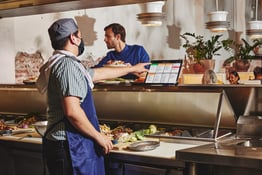Meet Rita — an enthusiastic greeter, hostess, food runner, and bona fide “happy birthday” singer. If it’s your birthday, she’ll scoop you some ice cream, too.
Trained in multiple roles, Rita is one of Chili’s newest employees. She’s also a robot, among fellow robotic pals like Flippy, Alfred, Sally, and Cecilia who’ve joined the industry in recent years, all proving robots in restaurants are no longer a far-fetched image of the future.
By now, we know the “future” is already here. And with it, the future of restaurants is changing.
From robot bartenders to fully autonomous pizza shops to mechanical arms taking over fryer stations, autonomous solutions are gradually entering restaurants worldwide. And analysts project continued growth, with the global robotics market expected to reach $147.26 billion by the end of 2025.
The bigger question now is not if robots will become a mainstay of the industry, but how fast the technology will continue to evolve and how its expansion will shape the industry at large. Will there be a day when we see robotics permeate not only QSR and fast casual chains, but independent and fine-dining establishments near and far?
When a labor shortage and technology advancements converge
Last summer, like many operators, Carlos Gazitua, CEO of Sergio’s Franchise Group and Restaurant, found himself in the middle of a staffing crisis. While teetering on having to close some of his locations, he decided to try something new – robotic bussers.
“It was a decision based out of desperation. We were experiencing the great resignation, and our servers were just flooded,” says Gazitua. “So we thought, what if the server doesn’t have to run back and forth, and we send the robot to run the food, and that way they could spend more time with customers, and maybe even get some extra tables.”
The pandemic added obvious strain to an industry already plagued with high turnover rates, and to this day, restaurants nationwide are operating with tighter teams. It’s pushing operators to increasingly embrace technology, like Bear Robotics’ Servi, which Gazitua now leases for every one of his 13 restaurants. The self-driving robotic food runner and busser uses laser-sensing technology and 3D cameras to move seamlessly between tables.
“Computer vision is a massive game changer that enables smarter systems,” says Dave Johnson, co-founder of Dexai Robotics, the company behind sous-chef robot Alfred. “Everyone is struggling [with staffing], but beyond that, the reason why we’re seeing so many more solutions now is a result of this combination of software and new technology – the ability to make these solutions smaller, cheaper, and easier to use.”
Benefits of robotics poised to soon make it a competitive staple
As technology advances, and robots’ skills expand, robotics increasingly appear as a promising labor solution. Yet, fear continues to circulate around these mechanical creations stealing human jobs, even as many industry jobs remain unfilled.
Most operators using the technology argue that robots have a greater potential to benefit the existing workforce.
“No one ever watches Star Wars and says, ‘Oh R2-D2 took someone’s job away’. They’re thinking about how R2-D2 is giving information and data to help make their pilot be a better pilot,” says Gazitua. “If we can make jobs easier, that’s a big win for our industry because we can’t offer virtual working like other industries, and because of virtual working, I don’t think our industry will ever go back to pre-pandemic labor levels.”
Gazitua says his waitstaff was initially skeptical of working among robotic bussers, but they quickly began seeing Servi as their own personal assistant, one that carries their plates and frees them up to engage with customers to earn higher tips. Gazitua’s currently looking at expanding his robotic investments, focusing on fulfilling roles that he says “people don’t jump for joy to do”, including dishwashing and cleaning bathrooms.
Some see robots like any other appliance. They all have an initial learning curve, but those that effectively solve challenges often become omnipresent.
“It’s like a dishwasher – you can’t run a restaurant without one these days. And there are a variety of solutions, but fundamentally you have a workflow that’s so important people would think it’s crazy not to have it,” says Johnson.
It’s the monotonous and mundane jobs that most industry robotics companies say they aim to offload so that staff can focus more on customer-facing and complex tasks.
“Labor intensive, repetitive and, frankly, dangerous tasks like manning the fryer aren’t roles that are attracting workers. And, even when they do, the turnover rate is so rapid that operators are in a continuous loop of hiring and training,” says Jake Brewer, chief strategy officer of Miso Robotics, the company behind Flippy, a robotic arm that automates the fyrer station.
Wing Zone, which recently announced it’s making Flippy its standard fry cook in 100-plus locations, says its future goal is to automate everything that can be automated, from tossing wings to filling soda cups. The plan will alleviate staffing issues, but Wing Zone says customer demand plays an equal role in the decision.
“Consumers have been taught you can have what you want, when you want, how you want it, and they now expect that not just from Amazon, but from everyone,” says David Bloom, Wing Zone’s chief development and operating officer. “[Automation] opens up revenue opportunities – a lot of our business is late-night, and now I’ll be able to service the 1 a.m. rush without needing to have a bunch of employees that don’t want to work that late.”
Robotics also improve efficiency and consistency, traits particularly valuable for QSRs. After all, isn’t that the core of what fast food promises? It shouldn’t matter what time you show up to Burger King, or to which location – the fries should be crispy and ready in minutes. Programmable robots can ensure that happens without error. And as a result, this can optimize both the guest experience and an operator’s bottom line.
“A robot’s never going to confuse tofu for turkey, and robots are just way better at controlling the amount of ingredients that go into each meal, so you can better manage quality control and also food waste,” says Johnson, noting that the precision, coupled with digital tracking, makes it’s also easier to track real-time inventory levels.
Moving beyond casual into fine-dining
Despite their potential, just like humans, robots are far from perfect. Currently, they shine brightest when doing repetitive, simple tasks. This creates a natural fit for frying french fries and assembling salad bowls. But the role of robots is less obvious when looking beyond QSR and fast casual. Many operators find it hard to imagine the technology entering fine-dining kitchens, at least in the near future.
“There are too many complicated dishes and different techniques, so I think people will spend more money to pay back of house staff,” says Gazitua.
Tools that increase consistency and efficiency are undoubtedly valuable for any restaurant. But fine dining is inextricably linked to other factors, like creativity and ambiance, which could make robots’ role more variable.
“If you’re talking about cooking where it’s more of an art, like a Michelin Star restaurant, it’s probably not happening,” says Bloom. “But if you’re talking about an upscale steakhouse, robots can detect temperature, accuracy, foodborne illnesses – and they can already do that as well as any person.”
The idea of robots rolling around the dining room of a Michelin-starred restaurant draws perhaps the most skepticism from operators.
“When you get into fine dining, you need to own the service, and it has to be personal,” says Stratis Morfogen, a New York restaurateur and founder of automat-based concept Brooklyn Dumpling Shop. “As much as I'm pro-technology, I'm pro-service when it comes to fine dining, and I don't think I'm ever going to change my runner, busboy, bartender, waiter, manager for fine dining.”
Not surprisingly, technology companies don’t typically share the same mindset. Plenty hold an end goal of integrating robotics into all kinds of restaurants. QSRs are simply the starting point, especially in the kitchen.
“We are initially focused on the fast-food industry because the sector has historically been challenged by very high-churn rates, even pre-pandemic,” says Brewer. “As we continue to engage with restaurant operators and industry partners, we’re learning about other tasks in need of automation and optimization, and we’re confident we’ll continue to offer technology solutions that go beyond the realm of fast food.”
From the start, Dexai Robotics says its mission has always been to build automation for all types of kitchens. The company is programming its Alfred robots to work with a wide variety of appliances found in restaurants both casual and fancy, including grills, steam tables, ovens, and fryers. Alfred’s current main feature is bowl assembly, but as new functions get rolled out, operators will receive a virtual software update to their existing Alfred. Once updated, that same Alfred’s skills will expand so that it can, for example, both make bowls and also operate the grill.
With the automation sector rapidly growing, Johnson expects to see more robotics solutions in fine dining kitchens within the next few years. Dexai is working on getting Alfred’s plating skills up to par.
Chains vs. independents: economics coupled with historically slow technology adoption rates may predict speed
Despite the expansive goals of robotics companies, robots like Rita and Flippy remain primarily siloed within nationwide chains. But many expect that to change, predicting a near-future uptick within independent restaurants, too.
“The big operators have the money to invest, but I think in the next five years, you’ll see a lot of independent operators have it in their operations, once the supply chain issues die down,” says Gazitua. “Once more independent operators see other operators doing it, it’ll filter down.”
Gazitua, who’s 13-location chain is infinitely smaller than, say, McDonalds’ 38,000-location enterprise, argues the technology is already reaching affordability. At this point, most companies lease their technology for a monthly fee, meaning you don’t have to put down thousands upfront for a robot.
“You can pay $1,000 a month and have a three-year contract [to get a Servi], and for most restaurants, that comes down to about $2.77 an hour, so if you need a food runner all the time, it’s actually cheaper,” says Gazitua. “I think when it gets to that $750 [per month] range, it’ll feel better for most people, but I think people can start now by picking their best store and playing with it.”
Dexai offers a pay-as-you-go model for Alfred so that operators only pay when the robot’s actually working. Dexai typically gets 10-percent of the retail cost, so for every $10 bowl the robot makes, Dexai gets $1.
“I think moving forward we’ll see more of these kinds of business modes to enable rapid adoption,” says Johnson.
Even as robots become increasingly economical, adoption rates in the independent sector may remain slow. The industry has a notorious reputation of being sluggish when it comes to adopting new technology. And while COVID-19 sped up the progression, robots aren’t exactly in the same realm as establishing a QR code menu or social media presence.
“I am surprised it’s not happening faster because when you look at how automation reduces labor costs, I actually do think it's affordable for independent mom and pops,” says Morfogen. “I just think that the technology is intimidating.”
Morfogen adds, “I believe what's going to really spearhead this in the future is the people cutting the checks, the investors who are going to say I’m not investing in anything that’s outdated. Money controls it all.”
Looking ahead: robotics role in reshaping the industry as a whole
The next few years could very likely reveal just how quickly robotics technology will expand across the industry. Regardless, it’s clear robots are here to stay, and at some point, they’ll arguably become a competitive staple for a significant portion of restaurants.
“We’re in the early stages, but we’re certainly in the most exciting time the industry’s ever seen, and also probably the most disruptive,” says Bloom. “Some brands are going to benefit greatly, and at the same time, some decades-old names are likely to go away. But there are fewer and fewer people today who think things are going to go back to the way they used to be.”
As more robots enter the workforce, it’s destined to not only change the restaurant landscape, but the job openings within it. There’s no doubt some people’s positions will get cut. But the hope is that it will also create additional opportunities while enhancing others that already exist.
“If done so correctly, automation’s going to provide restaurants the opportunity to pay more, give more benefits, and make it easier to work in the restaurant industry, and then there will also be this whole other line of business for IT personnel to do support,” says Gazitua.
Regardless of technology’s vast potential, few question whether or not the hardworking humans that’ve always made up this industry will continue to play an imperative role in the future.
“We’ll see more automated solutions [and] completely robot-run restaurants working 24/7 to fulfill takeout and delivery,” says Brewer. “But I also think the restaurant model we know today will evolve to focus more on the customer experience, which will be facilitated by both robots and humans. The human element will always be important to deliver a truly meaningful and delicious experience.”
Grace Dickinson is a reporter at Back of House. Send tips or inquiries to grace@backofhouse.io.





